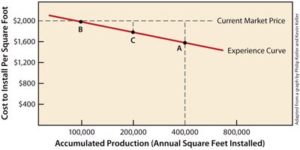When business is slow and credit is tight, you must do all you can do to preserve working capital, also referred to as operating capital. It’s an important financial metric calculated as current assets (cash, cash equivalents, accounts receivable, inventory) minus current liabilities (accrued expenses, notes payable, bank loans). It’s the difference between the money you’ve been paid and the cash you owe.
Decorative concrete businesses rely on short-term debt (such as credit card debt and short-term bank loans). Because of that, they benefit from cash-flow management strategies, especially in the off-season.
Depending on your current situation, here are seven strategies you might use to squeeze more working capital from your supply chain.
1. Finance your operations using your supply chain
The supply chain is full of financing options, especially if you’re one of the many professional installers who have begun offering credit terms to customers. And you can improve your working capital by offering them a discount for early payment. A common finance strategy, for example, is to offer a (small) percentage off the total bill if your customers pay within a short period of time. You’re basically paying customers to provide you with short-term financing.
The cost may be considerable, however. A credit of “2/10 net 30” (a 2 percent cash discount if the amount due in 30 days is paid within 10 days) translates into a 37 percent nominal annual interest rate. Whatever the terms, they should be clearly spelled out before you begin working.
Another option for improving working capital is to obtain short-term financing from lenders by pledging your accounts receivables as collateral. This is called “factoring” and it’s a source of fast cash when you’re unable to obtain short-term loans from a bank. Factoring companies give you an advance payment worth 70 to 90 percent of the total value of your receivables. They will give you the remaining balance (less a management fee) after your customers have paid the factoring company.
Factoring has increased in popularity as banks and other lenders have restricted their lending. But pledging your receivables is a relatively expensive source of financing — you’ll likely pay up to 7 percent of your receivables because we operate in a high-risk, fragmented industry. Keep in mind the real cost is less substantial because the factoring company takes on all the risk of default by the customer.
2. Shift your focus to the balance sheet
Normally, decorative concrete pros focus on profitability: increasing sales revenue (by bidding more projects) while strengthening the bottom line (by reducing expenses). Routine clerical work such as paying bills or calling on accounts receivables gets ignored. Granted, no one thinks back-office work is sexy. But savvy concrete pros are shifting their focus from the P&L statement to the balance sheet.
Some managers focus too much attention on managing inventory. Working capital includes other elements, too — payables and receivables. Minimizing the requirements of working capital necessitates a more synchronized approach to managing all three elements.
3. Prioritize your financial constraints
Decorative professionals think a lot about the ongoing recurring activities involved in running their business. They worry about where their next job is going to come from, what products to use, and how to install those products. Too many ignore finance issues until suppliers start screaming for payment. As a result of this lopsided managerial philosophy, they purchase inventory based solely on customer requirements, not financial constraints. These priorities should be reversed. Make working capital your primary constraint on inventory.
Again, this approach will require a balance between all three elements of working capital. It will make a dramatic impact on your procedures for managing the supply chain.
4. Adopt important inventory management procedures
Inventory management is the science of balancing what you want with what you need. Even small decorative installers will benefit from inventory management. Many keep product material on hand to avoid delays. For example, many of NewLook International’s loyal installers on the East Coast keep some of our stains or sealers in their garages so they can begin working on a project the moment they win the bid.
Stockpiling product like this is a risky financing decision since needed working capital is tied up in inventory. However, simply reducing inventory is not always the right strategy. It can have a damaging effect on your ability to provide legendary customer service.
Rather, sustainable cost reduction will most likely require improvements in project scheduling, customer demand planning and inventory policies. The savings may not be immediate. But these activities can dramatically increase your ability to compete in an economic downturn and position your decorative business for rapid growth when the economy rebounds.
5. Stretch your payables (diplomatically)
Preserve working capital by taking longer to pay suppliers. I know. I’m opening a can of worms here. But waiting until the last minute to pay down your balances gives you more breathing room. It conserves available cash for more immediate needs. Keep in mind I’m not advising you to pay late.
Of course, I should insert a word of caution. This approach can potentially compromise your relationships with suppliers. Worse, it could disrupt the efficiency of your entire supply chain by depriving partners of cash needed for operations, leading to quality problems or late deliveries. For example, NewLook has a few distributors who struggle to collect payment from contractors on account, especially during the winter season. This inhibits their ability to pay NewLook. When we don’t get paid, our working capital is restricted. And when we have limited working capital, we risk not having sufficient raw materials on hand to fulfill orders. And guess who ends up suffering most from lack of product availability?
Perhaps you can see why so many distributors are now requiring cash or at least a down payment from even their most respected contractors.
If you can mutually establish norms of conduct that ensure reasonable profits for all players in the vertical supply chain, taking advantage of the full credit term might be a reasonable option. Just do it intelligently.
6. Get more rigorous about receivables
I just told you about stretching payments to your suppliers. But guess what? If you’re one of the many decorative installers offering credit terms, your customers are thinking about doing the same thing to you. Focus on the payment performance of specific customers. Create a list of delinquent accounts and really work it over. Call or visit these customers frequently and encourage them to pay down their balance. Remember, timely and accurate invoicing is one of the most fundamental finance strategies you can adopt. You should also eliminate errors in your billing process that lead to costly delays in receiving payment.
7. Swap fixed costs for variable costs
Scrutinize your costs of doing business to identify all your fixed costs. Then examine how they might be converted into variable costs. Consider selling hard assets, such as a fleet vehicle or installation equipment, and leasing them back to raise needed working capital.
You can also expand your business to include contract work you wouldn’t normally perform. For example, some veteran decorative installers are willing to train newcomers to the industry even though it means they’re helping potential competition. Or perhaps you have extra storage space in your warehouse that you could lease out. While not always ideal, these are some of many solutions for raising emergency cash.















